


Key Points:
•Ecology is the study of the factors which control the abundance and distribution of organisms. It examines the flow of energy in living systems, and their interactions with the environment.
•A primary aspect of ecology is trophic interactions: who eats whom. Energy enters ecosystems from sunlight captured by photosynthesis; herbivores eat the plants; carnivores eat herbivores (and other carnivores); and decomposers break down dead tissue into its component parts.
•Under phyletic gradualism, then species don't have real beginnings or ends, and are just "chronospecies" with anagenetic origins; under the latter, the case can be made that species are "real" rather than purely arbitrary.
•In recent decade it has been recognized that evolution is highly controlled by development: this is represented by the new study of "evo-devo".
"Naturalists try to arrange the species, genera, and families in each class, on what is called the Natural System. But what is meant by this system? Some authors look at it merely as a scheme for arranging together those living objects which are most alike, and for separating those which are most unlike; or as an artificial means for enunciating, as briefly as possible, general propositions, that is, by one sentence to give the characters common, for instance, to all mammals, by another those common to all carnivora, by another those common to the dog-genus, and then by adding a single sentence, a full description is given of each kind of dog. The ingenuity and utility of this system are indisputable. But many naturalists think that something more is meant by the Natural System; they believe that it reveals the plan of the Creator; but unless it be specified whether order in time or space, or what else is meant by the plan of the Creator, it seems to me that nothing is thus added to our knowledge. Such expressions as that famous one of Linnaeus, and which we often meet with in a more or less concealed form, that the characters do not make the genus, but that the genus gives the characters, seem to imply that something more is included in our classification, than mere resemblance. I believe that something more is included; and that propinquity of descent, the only known cause of the similarity of organic beings, is the bond, hidden as it is by various degrees of modification, which is partially revealed to us by our classifications." -- Chapter 13, On the Origin of Species by Means of Natural Selection (1859), Charles Darwin
"The affinities of all the beings of the same class have sometimes been represented by a great tree. I believe this simile largely speaks the truth. The green and budding twigs may represent existing species; and those produced during each former year may represent the long succession of extinct species. At each period of growth all the growing twigs have tried to branch out on all sides, and to overtop and kill the surrounding twigs and branches, in the same manner as species and groups of species have tried to overmaster other species in the great battle for life. The limbs divided into great branches, and these into lesser and lesser branches, were themselves once, when the tree was small, budding twigs; and this connexion of the former and present buds by ramifying branches may well represent the classification of all extinct and living species in groups subordinate to groups. Of the many twigs which flourished when the tree was a mere bush, only two or three, now grown into great branches, yet survive and bear all the other branches; so with the species which lived during long-past geological periods, very few now have living and modified descendants. From the first growth of the tree, many a limb and branch has decayed and dropped off; and these lost branches of various sizes may represent those whole orders, families, and genera which have now no living representatives, and which are known to us only from having been found in a fossil state. As we here and there see a thin straggling branch springing from a fork low down in a tree, and which by some chance has been favoured and is still alive on its summit, so we occasionally see an animal like the Ornithorhynchus or Lepidosiren, which in some small degree connects by its affinities two large branches of life, and which has apparently been saved from fatal competition by having inhabited a protected station. As buds give rise by growth to fresh buds, and these, if vigorous, branch out and overtop on all sides many a feebler branch, so by generation I believe it has been with the great Tree of Life, which fills with its dead and broken branches the crust of the earth, and covers the surface with its ever branching and beautiful ramifications." -- Chapter 4, On the Origin of Species by Means of Natural Selection (1859), Charles Darwin
Intermediate between the atomic level of isotopic paleontology and the traditional histological-to-whole-body level of standard paleontology is the realm of molecular paleontology. Different kinds of biomolecules can yield different kinds of information.
One type of preserved molecule are grouped as biomarkers. These are various biologically-produced chemicals that can be preserved in sediment. Often they are not even associated with body fossils, but rather "leaked" into the depositional environment. They are typically discovered by chemical processing of organic-rich sediments. Biomarkers are extensively used in the fossil fuel industry, but can be used for many different other kinds of studies. For instance, you can use them to identify the presence of particular taxa; to examine sea surface temperature; to study hydrographic changes; and more.
Longer-chain molecules (proteins and other polymers) can also be preserved. Of course, the most significant long-chain molecules that can survive on at least the 100 kyr scale is DNA. Fossil DNA has helped to identify the phylogenetic placement of extinct species relative to modern ones, and is our primary evidence for introgression.
It is recognized that contemporary species decline might be incredibly fast by geologic timescales, it is going on slower than society notices. Additionally, by the time that field ecology really got going, especially in the marine realm (the mid-20th Century), the crisis was well underway. So how do we know what is really "natural"?
That is where conservation paleobiology comes in. Largely pioneered by invertebrate paleontologist Jeremy Jackson, conservation paleobiology works by looking at the fossil record of the latest Quaternary and early Holocene to get a description of the biodiversity of the contemporary species prior to any significant influence of humans. Furthermore, more ancient crises (like PETM and mass extinction recoveries) give us evidence of how the biosphere reacts to tremendous rapid changes. This evidence from the fossil record allows conservation biologists to make better plans in dealing with current and near-future changes.
It has been noted that conservation paleobiology gives us a tremendous amount of useful data, such as:
To Syllabus.
